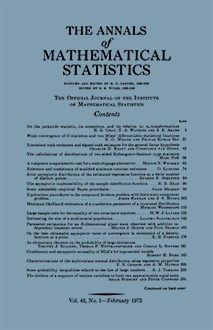Abstract
Non-orthogonal partitions of $n \times n$ Latin squares into $(n + 1)$ or $(n - 1)$ groups may be useful when further treatments are to be added to experimental designs in Latin squares. The different methods of constructing these partitions for $n = 4, 5$ or 6 are considered here. It is found that a partition into $(n + 1)$ groups is always possible when the Latin square has a directrix and a partition into $(n - 1)$ groups is possible whether or not there is a directrix. A complete enumeration of all possible partitions is given for the partition of $4 \times 4$ squares into 3 or 5 groups and that of $5 \times 5$ squares into 6 groups. Examples only are given for the partition of the $5 \times 5$ squares into 4 groups and the partition of the $6 \times 6$ squares into either 5 or 7 groups.
Citation
G. H. Freeman. "Some Non-Orthogonal Partitions of $4 \times 4, 5 \times 5$ and $6 \times 6$ Latin Squares." Ann. Math. Statist. 37 (3) 666 - 681, June, 1966. https://doi.org/10.1214/aoms/1177699460
Information





